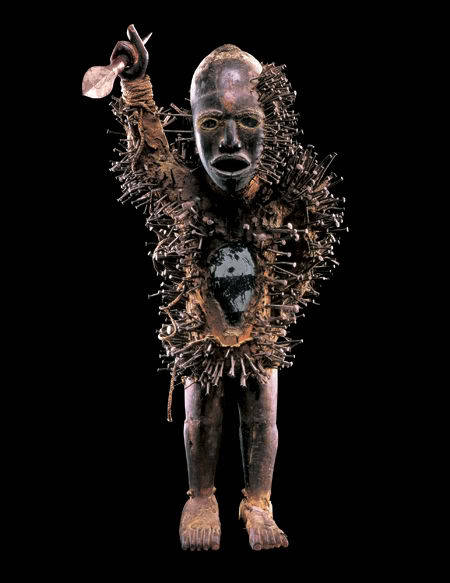For the Aboriginal tribes of Australia, the physical and the spiritual, immaterial worlds are often depicted as existing within one another. Thus, to fully understand the art of these tribes of Australia, it is important to understand the culture from which it is created.For each clan and its members, their lives are tied within
The Dreaming, or the spiritual, immaterial world that encompasses the lands, plants, animals, myths, and legends. In aboriginal belief, the world was created by the earliest Ancestor Spirits, and the spirits of these creative ancestors lie within the physical world that surrounds each clan (O'Riley). As these spirits traveled, they created the land and became part of it, remaining with it through all time. Thus, each clan is tied to a specific episode or section of
The Dreaming, and are responsible for representing and communicating with their Ancestor Spirits through rituals and art. Moreover, it is believed that the
mimi, or earliest ancestor spirits of the present Aboriginals, passed the art of painting and creation down through the generations(O'Riley). With this in mind, in Aboriginal belief, the artist is no longer seen as a creator, but is tasked with the responsibility of rediscovering, or literally,
representing the ancient spirits to his or her community. The art and rituals are seen as vessels to the spirit world, and everything within Aboriginal society: the
mimi, the spirit ancestors, and their presence in this world live in a timeless landscape.
 |
Fig. 1 "Hunter and Kangaroo" Paint on bark,
51 x 32" (129 x 81 cm). Oenpelli, Arnhem Land, Australia.
c. 1912. Museum Victoria, Melbourne, Australia. |
In understanding what influences Aboriginal art, we can now dissect and begin to fully appreciate this ancient art form. When looking at this piece, known simply as Hunter and Kangaroo, several key elements begin to come forth. In looking at the piece as a whole, the canvas itself lends to the design. The aboriginals were constantly in contact with their spirit ancestors, who existed in the world around them, and this knowledge of existence is evident in the canvas and medium. The canvas is the bark of the stringbark tree, also known as the Eucalyptus Tree (Eucalyptus tetradonta) (Resture). Also, the paint was often derived from the surrounding landscape: the cliffs bordering the sea, the rocks, and even roots and plants, such as flowers. This respect for nature and utilization of natural materials only continues into the subject of the painting. There appears to be a hunter spearing a kangaroo, but neither are depicted in the normal form. Both utilize what was known as the X-ray style, common to the Oenpelli people of the Arnhem Lands (O'Riley). In looking at the individual figures, it is evident an attempt at understanding the inner form and essence of each figure. As hunter understands his prey, so does the opposite, thus the image creates a universal respect between both figures. Furthering this idea, the Kangaroo is larger than the hunter, emphasizing the idea that without him, the hunter would die and neither would exist. In essence, this piece is a commentary on the Aboriginal ideas of ancestry and the spirit world. As discussed before, the Aborigines believed art was a vessel for communicating with the spirit world and their ancestors, and that this world existed everywhere around them; in nature, in the landscape and in themselves. In essence, this piece is acknowledging that existence; it is asking the spirit ancestors for a successful hunt, but moreover acknowledging the idea that these ancestors exist within and around each person, and that a mutual respect exists between every living thing. What we are given is not a piece of art, but a vessel that embodies the spiritual that the Aborigines access every day, strengthening the link from past to present.
References:
Kampen O'Riley, Michael. "The Pacific." In Art Beyond the West, 207-208. 2nd ed.
Upper Saddle River, NJ: Pearson Prentice Hall, 2006.
Resture, Jane. "Australia: Aboriginal Bark Painting." Jane's Oceania. March, 2012.
Accessed October, 2014. http://www.janesoceania.com/
australia_aboriginal_barkpainting/index1.html
Fig. 1. Oenpelli. Hunter and Kangaroo. 1912, Paint on Bark. Arnhem Land. Museum
Victoria, Melbourne, Australia. In Art Beyond the West, 208.



.jpg)









